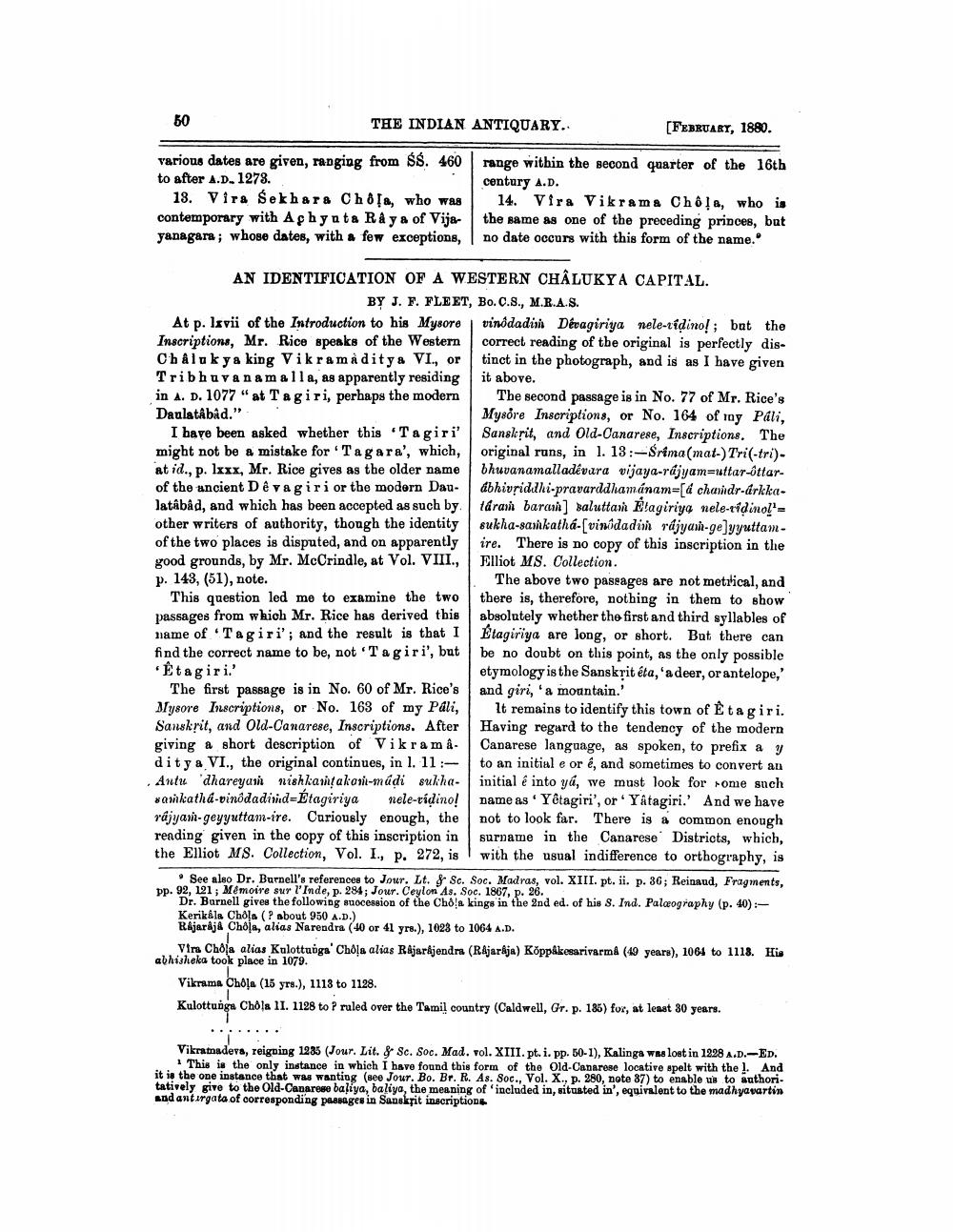________________
50
THE INDIAN ANTIQUARY..
[FEBRUARY, 1880.
various dates are given, ranging from $8.460 to after A.D. 1278.
13. Vira Sekhara Choo, who was contemporary with A chyota Raya of Vijayanagara; whose dates, with a few exceptions,
range within the second quarter of the 16th century A.D.
14. Vira Vikrama Cha, who is the same as one of the preceding princes, but no date occurs with this form of the name."
AN IDENTIFICATION OF A WESTERN CHALUKYA CAPITAL.
BY J. F. FLEET, Bo.C.S., M.R.A.S. At p. lxvii of the Introduction to his Mysore vinddadin Devagiriya nele-tidino!; but the Inscriptions, Mr. Rice speaks of the Western correct reading of the original is perfectly disChâluk ya king Vikramaditya VI., or tinct in the photograph, and is as I have given Tribhuvanamalla, as apparently residing it above. in A. D. 1077" at Tagiri, perhaps the modern The second passage is in No. 77 of Mr. Rice's Daulatâbid."
Mysore Inscriptions, or No. 164 of roy Páli, I have been asked whether this Tagiri' Sanslesit, and Old-Canarese, Inscriptions. The might not be a mistake for 'Tagara', which, original runs, in l. 13:- Srima(mat) Tri-tri). at id., p. lxxx, Mr. Rice gives as the older name bhuvanamalladivara vijaya-rdjyam-uttar-óttar. of the ancient Dévagiri or the modern Dau. abhivsiddhi.pravarddhamánam-[& chaidr-arkkalatábåd, and which has been accepted as such by tarari baran) saluttaw lagiriya nele-ridino!' other writers of authority, though the identity sukha-sasikatha-(vinidadi rájyah-ge]yyuttam. of the two places is disputed, and on apparently ire. There is no copy of this inscription in the good grounds, by Mr. McCrindle, at Vol. VIII., Elliot MS. Collection. p. 143, (51), note.
The above two passages are not metilical, and This question led me to examine the two there is, therefore, nothing in them to show passages from which Mr. Rice has derived this absolutely whether the first and third syllables of name of Tagiri'; and the result is that I Étagiriya are long, or short. But there can find the correct name to be, notTagiri', but be no doubt on this point, as the only possible Etagiri.'
etymology is the Sanskrit éta, 'a deer, or antelope,' The first passage is in No. 60 of Mr. Rice's and giri, 'a mountain.' Mysore Inscriptions, or No. 163 of my Páli, It remains to identify this town of Êtagiri. Sanskrit, and Old-Canarese, Inscriptions. After Having regard to the tendency of the modern giving a short description of Vikrama. Canarese language, as spoken, to prefix a y ditya VI., the original continues, in 1. 11:- to an initial e or e, and sometimes to convert an Antu 'dhareya nishkautakori-madi sukha. initial é into ya, we must look for some such sarikathá-vinodadinid=Étagiriya nele-ridino! Dame as 'Yêtagiri', or 'Yatagiri.' And we have rajyan-geyyuttam-ire. Curiously enough, the not to look far. There is a common enough reading given in the copy of this inscription in surname in the Canarese Districts, which, the Elliot MS. Collection, Vol. I., p. 272, is with the usual indifference to orthography, is
See also Dr. Burnell's references to Jour. Lt. & Sc. Soc. Madras, vol. XIII. pt. ii. p. 36; Reinaud, Fragments, pp. 92, 121, Mémoire sur l'Inde, p. 284; Jour. Ceylon As. Soc. 1867, p. 26.
Dr. Barnell gives the following succession of the Chola kings in the 2nd ed. of his 8. Ind. Palaography (p. 40) :Kerikála Chola (P about 950 A.D.). Rejardja Chola, alias Narendra (40 or 41 yrs.), 1028 to 1064 A.D.
Vira Chola alias Kulottunga' Chola alias Rajarajendra (Rajaraja) KõppakesarivarmA (49 years), 1064 to 1118. His abhisheka took place in 1079.
Vikrama Chóļa (15 yrs.), 1113 to 1128. Kulottunga Chola II. 1128 to ? ruled over the Tamil country (Caldwell, Gr. p. 186) for, at least 30 years.
Vikratnadeva, reigning 1285 (Jour. Lit. & Sc. Soc. Mad. Fol. XIII. pt. i. pp. 60-1), Kalinga was lost in 1228 A.D.-ED.
This is the only instance in which I have found this form of the Old-Canarese locative spelt with the !. And it is the one instance that was wanting (see Jour. Bo. Br. R. As. Soc.. Vol. X. p. 280, note 37) to enable us to authoritatively give to the Old-Canarese baliya, baliya, the meaning of 'included in, situated in', equivalent to the madhyavartin and antirgata of corresponding passages in Sanskrit inscriptions




